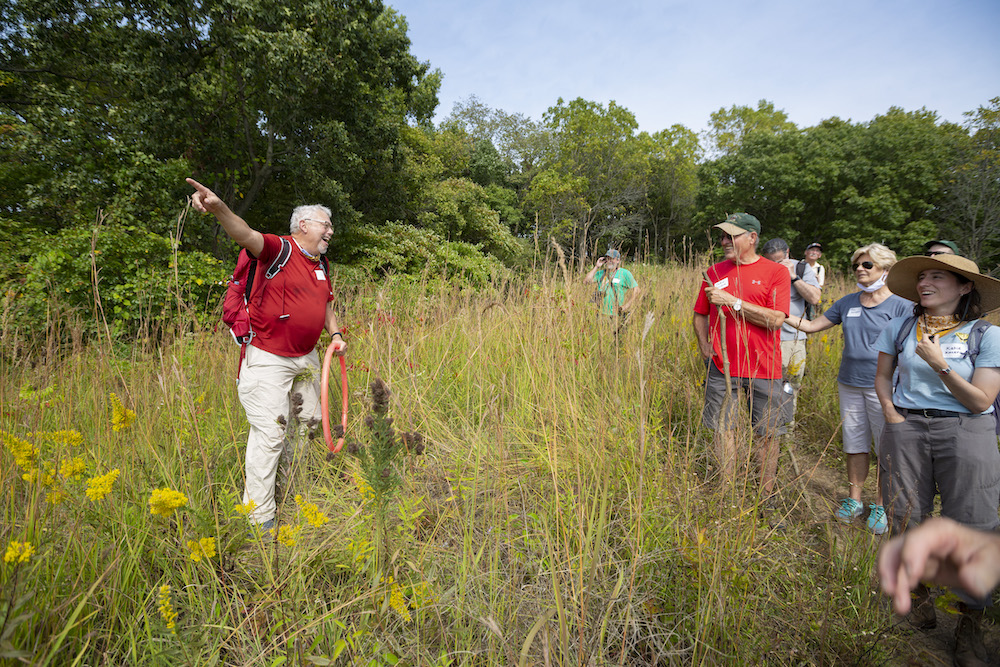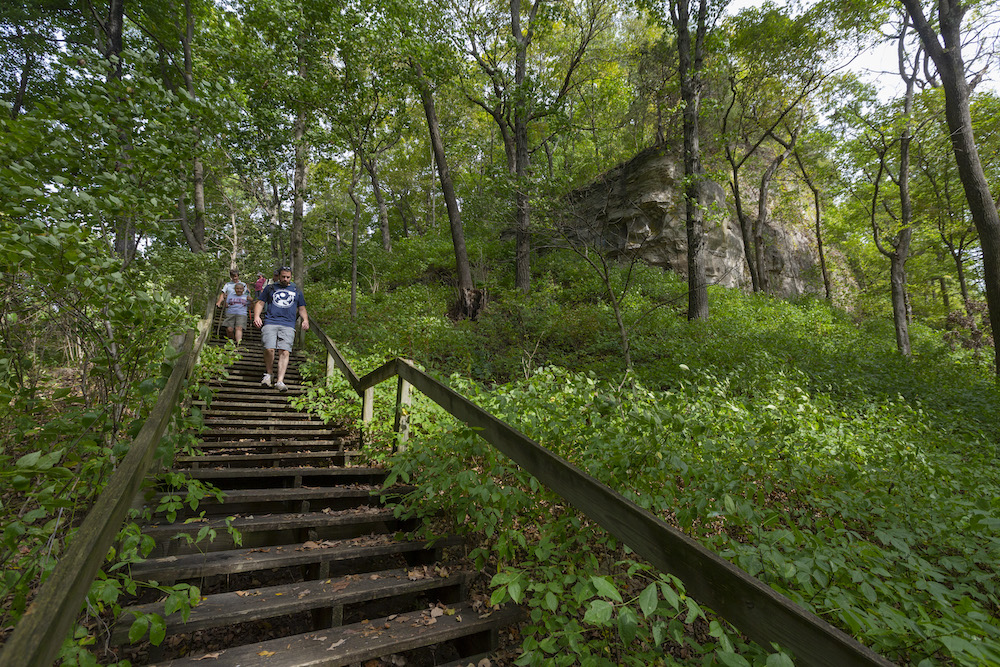
Photo courtesy of the Illinois Department of Natural Resources.



Photo courtesy of the Illinois Department of Natural Resources.

For those of us who are engaged with the natural world, there are sites that we travel to and appreciate and then there are those special places that we return to again and again. One such beloved place is Fults Hill Prairie Nature Preserve, a 532-acre upland habitat along the Mississippi River bluff that is part of the 997-acre Fults Hill State Natural Area located in Monroe County, Illinois. Fults Hill Prairie has been cared for and managed by generations of people, beginning with indigenous people who first used prescribed fire to suppress woody succession and continuing today with a dedicated group of individuals working together to conserve and restore this unique place.

Fults Hill Prairie was dedicated as an Illinois Nature Preserve in October 1970. COVID-19 meant the anniversary couldn’t be celebrated in 2020, so on October 9, 2021, the prairie got a much deserved, though belated, celebration of this important milestone. The Illinois Nature Preserves Commission (INPC), Illinois Department of Natural Resources (IDNR), Friends of Illinois Nature Preserves, and Clifftop held a ceremony on a gorgeous, sunny day that included presentations, a tour guided by past and present staff of the INPC, Illinois Natural History Survey, and IDNR Natural Heritage Biologists; and, of course, a very big cake. More than 100 people gathered to acknowledge the hard work that has been conducted at Fults Hill Prairie Nature Preserve over the years and, for those brave enough to tackle all the stairs, to enjoy a walk through the prairie and other habitats with some of those who know Fults best. For those who could not make it there that day, several videos were taken throughout the event and can be accessed here: https://www.youtube.com/user/clifftopnfp.

Someone who doesn’t know much about the natural history of Illinois might wonder what all the fuss is about. Though once they realize how landcover has changed in Illinois over the last 250 years, it is abundantly apparent why places like Fults Hill Prairie deserve to be celebrated. Illinois covers approximately 36 million acres, and historically, about 22 million of those acres were covered by prairie. Today, however, only about 2,500 acres of prairie remain. And of the hill prairies that once existed in Illinois, only about 600 acres remain—most of the hill prairies have been destroyed or degraded by grazing; urban or agricultural development; invasion by non-native, invasive species; and vegetative succession as the grasslands gave way to the nearby woodlands due to lack of fire. The fact that Fults Hill Prairie still even exists is a testament to the dedication of the staff of conservation agencies and organizations, contractors, researchers, and volunteers who have all stewarded, monitored, and protected the site for decades and who continue to conserve and restore the different habitats located there.

Fults Hill Prairie Nature Preserve has an impressive roster of accolades. In addition to being the first nature preserve dedicated in Monroe County, Fults Hill Prairie Nature Preserve was also the 30th nature preserve to be dedicated in Illinois and the first dedicated hill prairie preserve in the state. In 1986 it was recognized federally by the U.S. Department of Interior as a National Natural Landmark, one of only 18 sites recognized in Illinois.
So, what does it mean to be an Illinois Nature Preserve? It means that the land has the strongest permanent, legal protection that can be given to land in Illinois. The Illinois Nature Preserves Commission administers the preserve system to protect and steward Illinois’ remaining high-quality examples of our natural heritage on both public and private lands. This protection is much deserved at Fults Hill Prairie Nature Preserve since this patchwork of oak-dominated woodlands, limestone glades, sink hole ponds, savannas, and hill prairies support a variety of rare, threatened and endangered, plant and animal species, as well as Species in Greatest Conservation Need. The preserve is located in the narrow bluff corridor of the unglaciated Northern Section of the Ozark Natural Division. This corridor harbors several species found nowhere else in Illinois, though they are more commonly found across the river in the Missouri Ozarks. Fults is also home to many species that may be more familiar such as butterfly milkweed, spiderwort, big bluestem, pale purple coneflower, rose-breasted grosbeak, wild turkey, and several species of warblers and hawks. Because of its designation as a nature preserve, this site is being managed to conserve and restore its natural ecological conditions and natural resources.

Ownership of this land has changed over time, but since the 1970s the site has been owned by the IDNR which manages the site using multiple techniques including prescribed burns and removal of invasive species and woody vegetation. Rigorous management of Fults Hill Prairie Nature Preserve is necessary to avoid loss of biodiversity and to protect the habitats required by the threaten and endangered species that live there. There is a current State Wildlife Grant (SWG) project (T–116–D1) that focused on hill prairies, including Fults Hill Prairie Nature Preserve. Some of the expected benefits of this project include:
Learn more about this project at at: https://www2.illinois.gov/dnr/conservation/IWAP/Pages/Public-Lands-Hill-Prairie.aspx

Visitors to site can make a day of it and experience the uplands of Fults Hill Prairie Nature Preserve and the lowlands of Kidd Lake Marsh State Natural Area just across Bluff Road. And speaking of visitors, there is a great opportunity to visit the site coming up very soon. During the ceremony, Friends of Illinois Nature Preserves announced a Conservation Community Kickoff event at Fults Hill Prairie Nature Preserve that will be held on Saturday, November 6, 2021 to grow the community of volunteers. Such a lovely, biologically diverse place needs many friends, and volunteers willing to share their time and skills are more than welcome. If you are interested, contact Friends of Illinois Nature Preserves for more details about the November 6th event. For those who may wish to visit this enchanting site at a later date, more information is available at the IDNR’s Fults Hill Prairie Nature Preserve page.

Laura Kammin is a Natural Resources Specialist with the National Great Rivers Research and Education Center. She formerly held positions at Illinois-Indiana Sea Grant, University of Illinois Extension, Prairie Rivers Network and the Illinois Natural History Survey. She received her master’s degree in wildlife ecology from the University of Illinois, Urbana-Champaign.
Isabella Newingham is the new State Wildlife Action Plan and Aquatic Ecology GPSI intern at the Illinois Department of Natural Resources. She graduated with a bachelor’s degree in Biology from Millikin University in 2020. She spent the year following graduation teaching at a local high school before starting at the University of Illinois Springfield to complete a master’s degree in Environmental Sciences with a concentration in Sustainable Development and Policy. While at Millikin University she completed research to observe behavioral responses in millipedes.
Submit a question for the author
Question: Are the trails open this time of year?